2019 KIA SPORTAGE alarm
[x] Cancel search: alarmPage 383 of 607
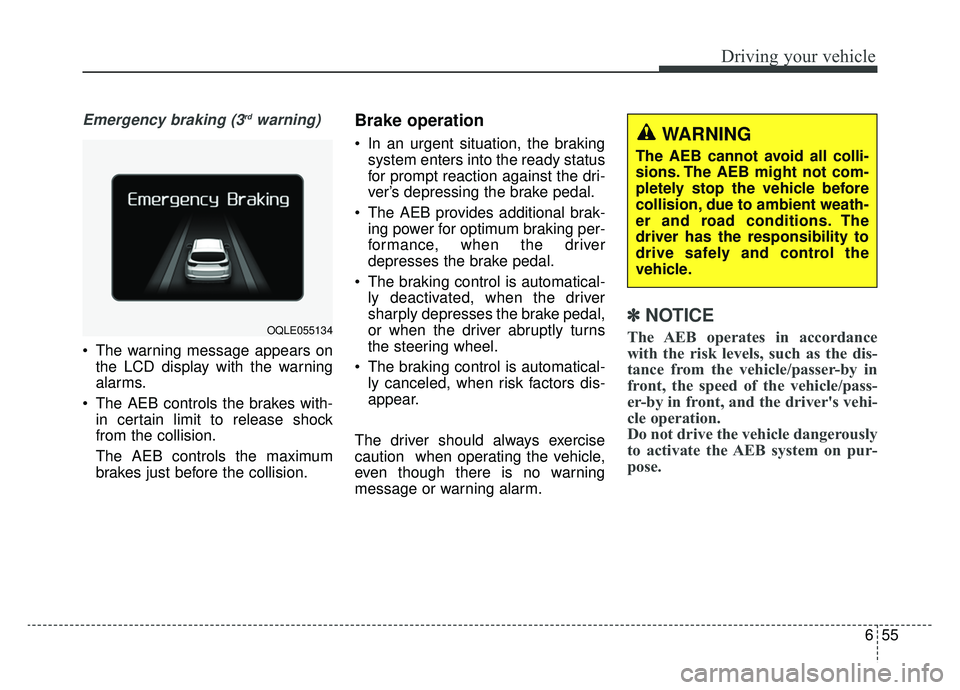
655
Driving your vehicle
Emergency braking (3rdwarning)
The warning message appears onthe LCD display with the warning
alarms.
The AEB controls the brakes with- in certain limit to release shock
from the collision.
The AEB controls the maximum
brakes just before the collision.
Brake operation
In an urgent situation, the brakingsystem enters into the ready status
for prompt reaction against the dri-
ver’s depressing the brake pedal.
The AEB provides additional brak- ing power for optimum braking per-
formance, when the driver
depresses the brake pedal.
The braking control is automatical- ly deactivated, when the driver
sharply depresses the brake pedal,
or when the driver abruptly turns
the steering wheel.
The braking control is automatical- ly canceled, when risk factors dis-
appear.
The driver should always exercise
caution when operating the vehicle,
even though there is no warning
message or warning alarm.
✽ ✽ NOTICE
The AEB operates in accordance
with the risk levels, such as the dis-
tance from the vehicle/passer-by in
front, the speed of the vehicle/pass-
er-by in front, and the driver's vehi-
cle operation.
Do not drive the vehicle dangerously
to activate the AEB system on pur-
pose.OQLE055134
WARNING
The AEB cannot avoid all colli-
sions. The AEB might not com-
pletely stop the vehicle before
collision, due to ambient weath-
er and road conditions. The
driver has the responsibility to
drive safely and control the
vehicle.
Page 386 of 607
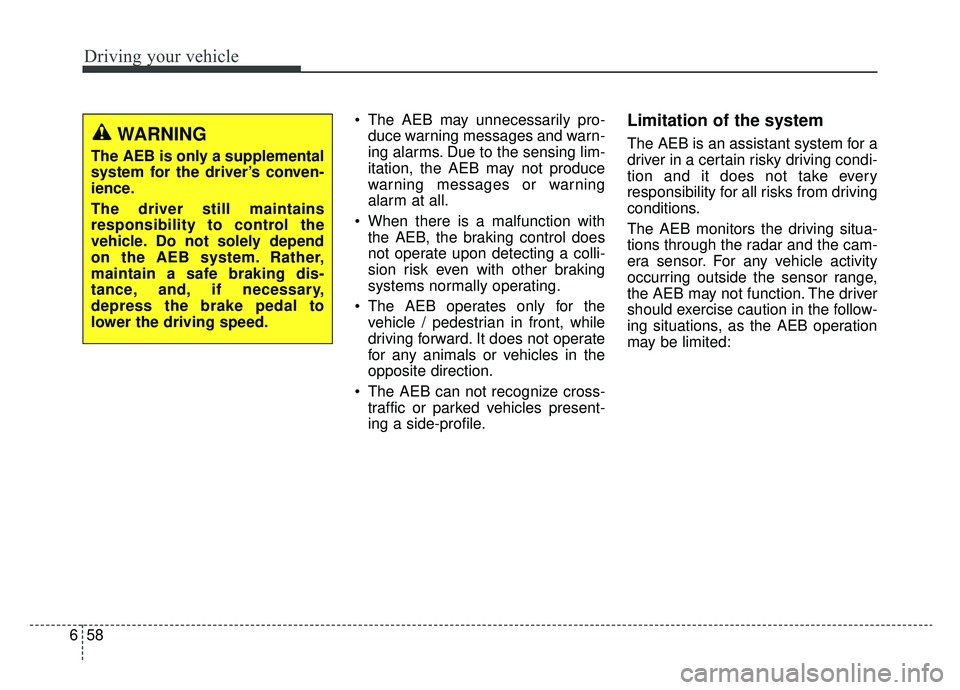
Driving your vehicle
58
6
The AEB may unnecessarily pro-
duce warning messages and warn-
ing alarms. Due to the sensing lim-
itation, the AEB may not produce
warning messages or warning
alarm at all.
When there is a malfunction with the AEB, the braking control does
not operate upon detecting a colli-
sion risk even with other braking
systems normally operating.
The AEB operates only for the vehicle / pedestrian in front, while
driving forward. It does not operate
for any animals or vehicles in the
opposite direction.
The AEB can not recognize cross- traffic or parked vehicles present-
ing a side-profile.Limitation of the system
The AEB is an assistant system for a
driver in a certain risky driving condi-
tion and it does not take every
responsibility for all risks from driving
conditions.
The AEB monitors the driving situa-
tions through the radar and the cam-
era sensor. For any vehicle activity
occurring outside the sensor range,
the AEB may not function. The driver
should exercise caution in the follow-
ing situations, as the AEB operation
may be limited:WARNING
The AEB is only a supplemental
system for the driver’s conven-
ience.
The driver still maintains
responsibility to control the
vehicle. Do not solely depend
on the AEB system. Rather,
maintain a safe braking dis-
tance, and, if necessary,
depress the brake pedal to
lower the driving speed.
Page 387 of 607
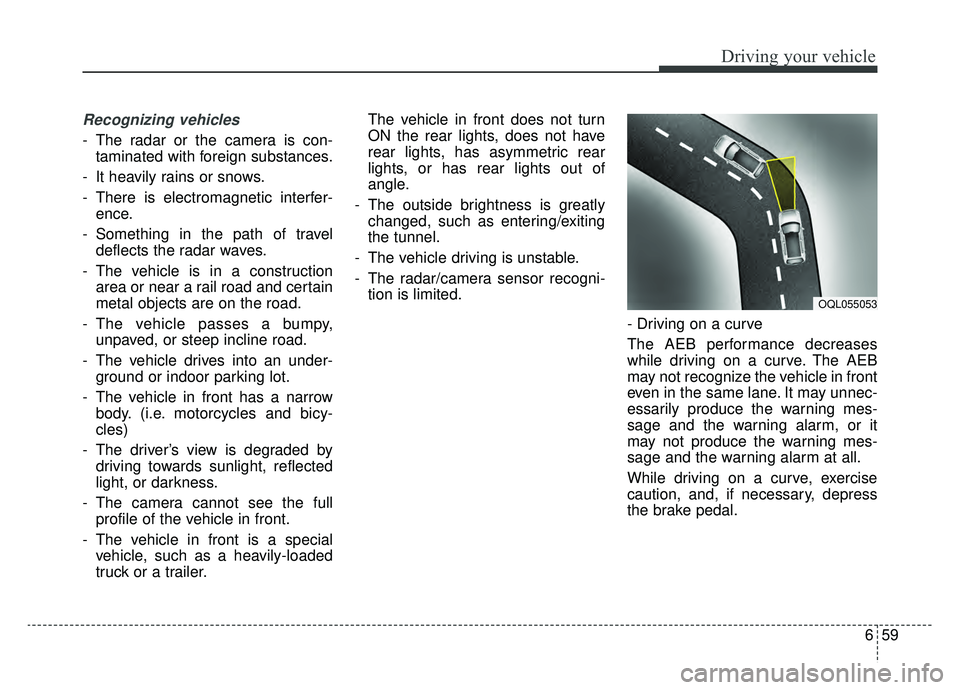
659
Driving your vehicle
Recognizing vehicles
- The radar or the camera is con-taminated with foreign substances.
- It heavily rains or snows.
- There is electromagnetic interfer- ence.
- Something in the path of travel deflects the radar waves.
- The vehicle is in a construction area or near a rail road and certain
metal objects are on the road.
- The vehicle passes a bumpy, unpaved, or steep incline road.
- The vehicle drives into an under- ground or indoor parking lot.
- The vehicle in front has a narrow body. (i.e. motorcycles and bicy-
cles)
- The driver’s view is degraded by driving towards sunlight, reflected
light, or darkness.
- The camera cannot see the full profile of the vehicle in front.
- The vehicle in front is a special vehicle, such as a heavily-loaded
truck or a trailer. The vehicle in front does not turn
ON the rear lights, does not have
rear lights, has asymmetric rear
lights, or has rear lights out of
angle.
- The outside brightness is greatly changed, such as entering/exiting
the tunnel.
- The vehicle driving is unstable.
- The radar/camera sensor recogni- tion is limited.
- Driving on a curve
The AEB performance decreases
while driving on a curve. The AEB
may not recognize the vehicle in front
even in the same lane. It may unnec-
essarily produce the warning mes-
sage and the warning alarm, or it
may not produce the warning mes-
sage and the warning alarm at all.
While driving on a curve, exercise
caution, and, if necessary, depress
the brake pedal.
OQL055053
Page 388 of 607
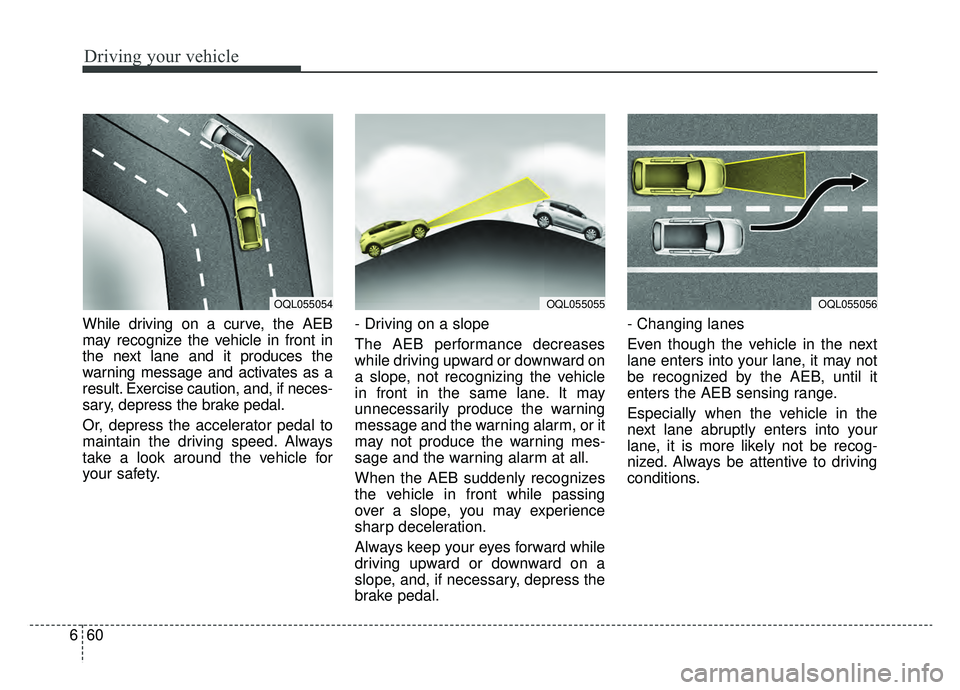
Driving your vehicle
60
6
While driving on a curve, the AEB
may recognize the vehicle in front in
the next lane and it produces the
warning message and activates as a
result. Exercise caution, and, if neces-
sary, depress the brake pedal.
Or, depress the accelerator pedal to
maintain the driving speed. Always
take a look around the vehicle for
your safety. - Driving on a slope
The AEB performance decreases
while driving upward or downward on
a slope, not recognizing the vehicle
in front in the same lane. It may
unnecessarily produce the warning
message and the warning alarm, or it
may not produce the warning mes-
sage and the warning alarm at all.
When the AEB suddenly recognizes
the vehicle in front while passing
over a slope, you may experience
sharp deceleration.
Always keep your eyes forward while
driving upward or downward on a
slope, and, if necessary, depress the
brake pedal.- Changing lanes
Even though the vehicle in the next
lane enters into your lane, it may not
be recognized by the AEB, until it
enters the AEB sensing range.
Especially when the vehicle in the
next lane abruptly enters into your
lane, it is more likely not be recog-
nized. Always be attentive to driving
conditions.
OQL055054OQL055055OQL055056
Page 402 of 607
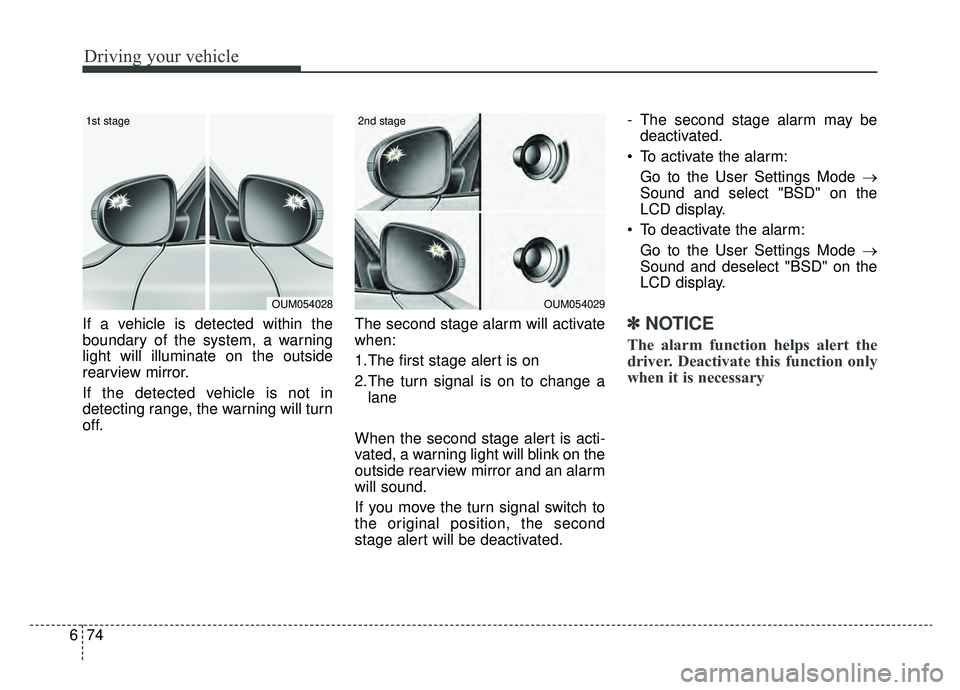
Driving your vehicle
74
6
If a vehicle is detected within the
boundary of the system, a warning
light will illuminate on the outside
rearview mirror.
If the detected vehicle is not in
detecting range, the warning will turn
off. The second stage alarm will activate
when:
1.The first stage alert is on
2.The turn signal is on to change a
lane
When the second stage alert is acti-
vated, a warning light will blink on the
outside rearview mirror and an alarm
will sound.
If you move the turn signal switch to
the original position, the second
stage alert will be deactivated. - The second stage alarm may be
deactivated.
To activate the alarm: Go to the User Settings Mode →
Sound and select "BSD" on the
LCD display.
To deactivate the alarm: Go to the User Settings Mode →
Sound and deselect "BSD" on the
LCD display.✽ ✽
NOTICE
The alarm function helps alert the
driver. Deactivate this function only
when it is necessary
OUM054029
2nd stage
OUM054028
1st stage
Page 539 of 607
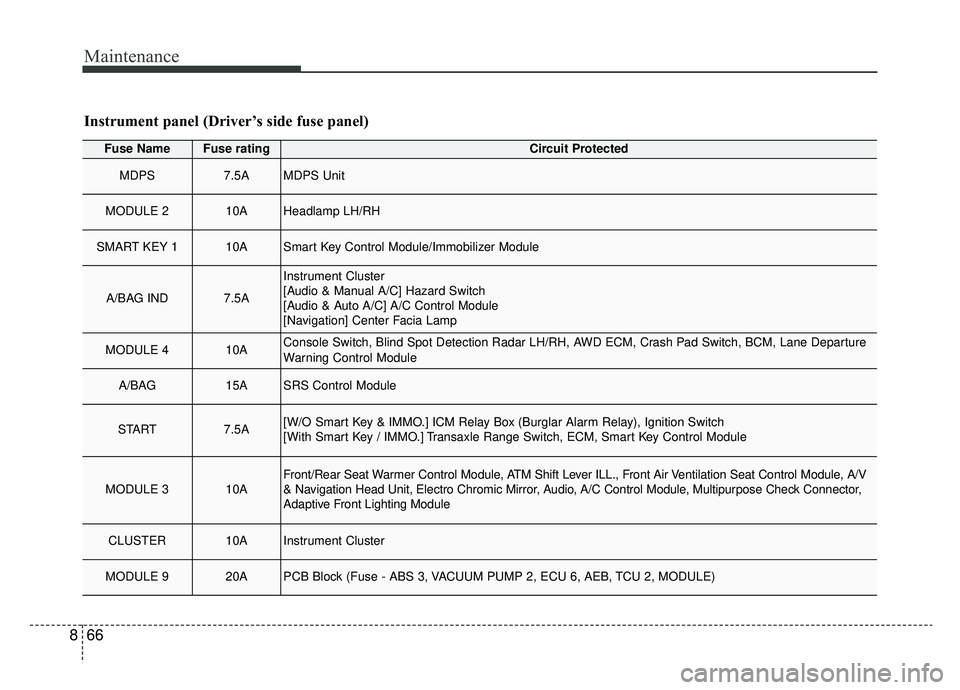
Maintenance
66
8
Fuse NameFuse ratingCircuit Protected
MDPS7.5AMDPS Unit
MODULE 210AHeadlamp LH/RH
SMART KEY 110ASmart Key Control Module/Immobilizer Module
A/BAG IND7.5A
Instrument Cluster
[Audio & Manual A/C] Hazard Switch
[Audio & Auto A/C] A/C Control Module
[Navigation] Center Facia Lamp
MODULE 410AConsole Switch, Blind Spot Detection Radar LH/RH, AWD ECM, Crash Pad Switch, BCM, Lane Departure
Warning Control Module
A/BAG15ASRS Control Module
START7.5A[W/O Smart Key & IMMO.] ICM Relay Box (Burglar Alarm Relay), Ignition Switch
[With Smart Key / IMMO.] Transaxle Range Switch, ECM, Smart Key Control Module
MODULE 310AFront/Rear Seat Warmer Control Module, ATM Shift Lever ILL., Front Air Ventilation Seat Control Module, A/V
& Navigation Head Unit, Electro Chromic Mirror, Audio, A/C Control Module, Multipurpose Check Connector,
Adaptive Front Lighting Module
CLUSTER10AInstrument Cluster
MODULE 920APCB Block (Fuse - ABS 3, VACUUM PUMP 2, ECU 6, AEB, TCU 2, MODULE)
Instrument panel (Driver’s side fuse panel)
Page 547 of 607
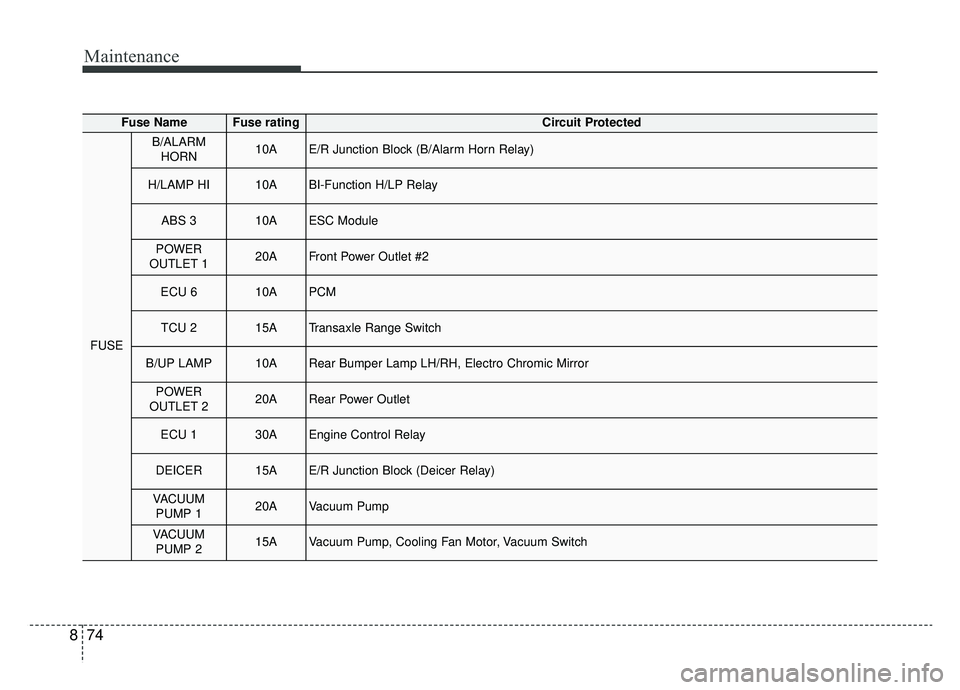
Maintenance
74
8
Fuse NameFuse ratingCircuit Protected
FUSE
B/ALARM
HORN10AE/R Junction Block (B/Alarm Horn Relay)
H/LAMP HI10ABI-Function H/LP Relay
ABS 310AESC Module
POWER
OUTLET 120AFront Power Outlet #2
ECU 610APCM
TCU 215ATransaxle Range Switch
B/UP LAMP10ARear Bumper Lamp LH/RH, Electro Chromic Mirror
POWER
OUTLET 220ARear Power Outlet
ECU 130AEngine Control Relay
DEICER15AE/R Junction Block (Deicer Relay)
VACUUM PUMP 120AVacuum Pump
VACUUMPUMP 215AVacuum Pump, Cooling Fan Motor, Vacuum Switch
Page 605 of 607
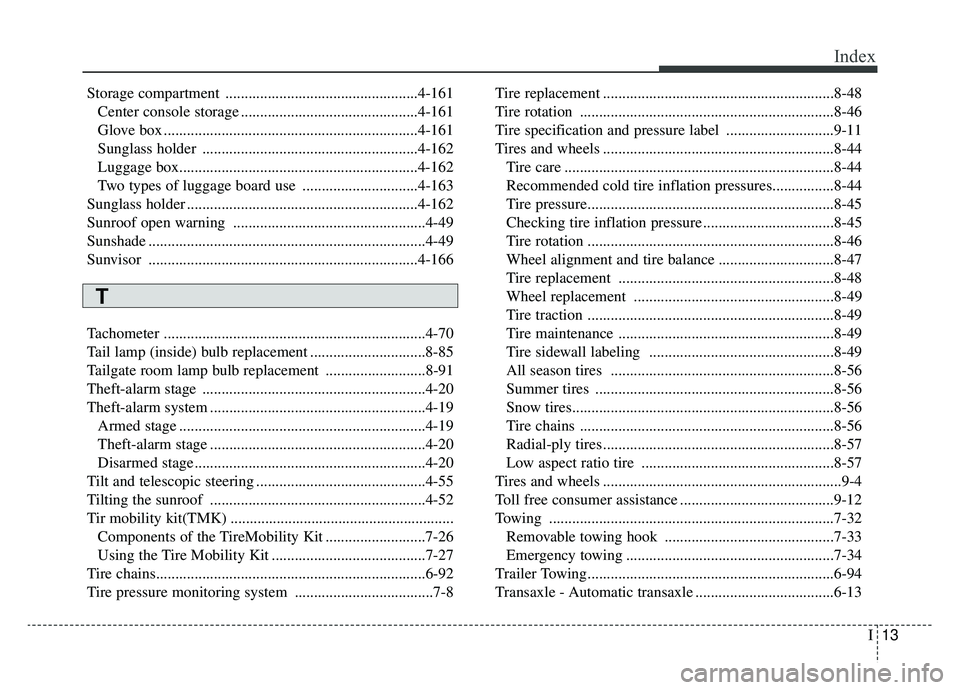
I13
Index
Storage compartment ..................................................4-161Center console storage ..............................................4-161
Glove box ..................................................................4-161
Sunglass holder ........................................................4-162
Luggage box.............................................................\
.4-162
Two types of luggage board use ..............................4-163
Sunglass holder ............................................................4-162
Sunroof open warning ..................................................4-49
Sunshade ........................................................................\
4-49
Sunvisor ......................................................................4-\
166
Tachometer ....................................................................4-70\
Tail lamp (inside) bulb replacement ..............................8-85
Tailgate room lamp bulb replacement ..........................8-91
Theft-alarm stage ..........................................................4-20
Theft-alarm system ........................................................4-19 Armed stage ................................................................4-19
Theft-alarm stage ........................................................4-20
Disarmed stage ............................................................4-20
Tilt and telescopic steering ............................................4-55
Tilting the sunroof ........................................................4-52
Tir mobility kit(TMK) .......................................................... Components of the TireMobility Kit ..........................7-26
Using the Tire Mobility Kit ........................................7-27
Tire chains......................................................................6-\
92
Tire pressure monitoring system ....................................7-8 Tire replacement ............................................................8-48
Tire rotation ..................................................................8-46
Tire specification and pressure label ............................9-11
Tires and wheels ............................................................8-44
Tire care ......................................................................8-\
44
Recommended cold tire inflation pressures................8-44
Tire pressure................................................................8-45
Checking tire inflation pressure ..................................8-45
Tire rotation ................................................................8-46
Wheel alignment and tire balance ..............................8-47
Tire replacement ........................................................8-48
Wheel replacement ....................................................8-49
Tire traction ................................................................8-49
Tire maintenance ........................................................8-49
Tire sidewall labeling ................................................8-49
All season tires ..........................................................8-56
Summer tires ..............................................................8-56
Snow tires....................................................................8-56\
Tire chains ..................................................................8-56
Radial-ply tires ............................................................8-57
Low aspect ratio tire ..................................................8-57
Tires and wheels ..............................................................9-4
Toll free consumer assistance ........................................9-12
Towing ........................................................................\
..7-32 Removable towing hook ............................................7-33
Emergency towing ......................................................7-34
Trailer Towing................................................................6-94
Transaxle - Automatic transaxle ....................................6-13
T